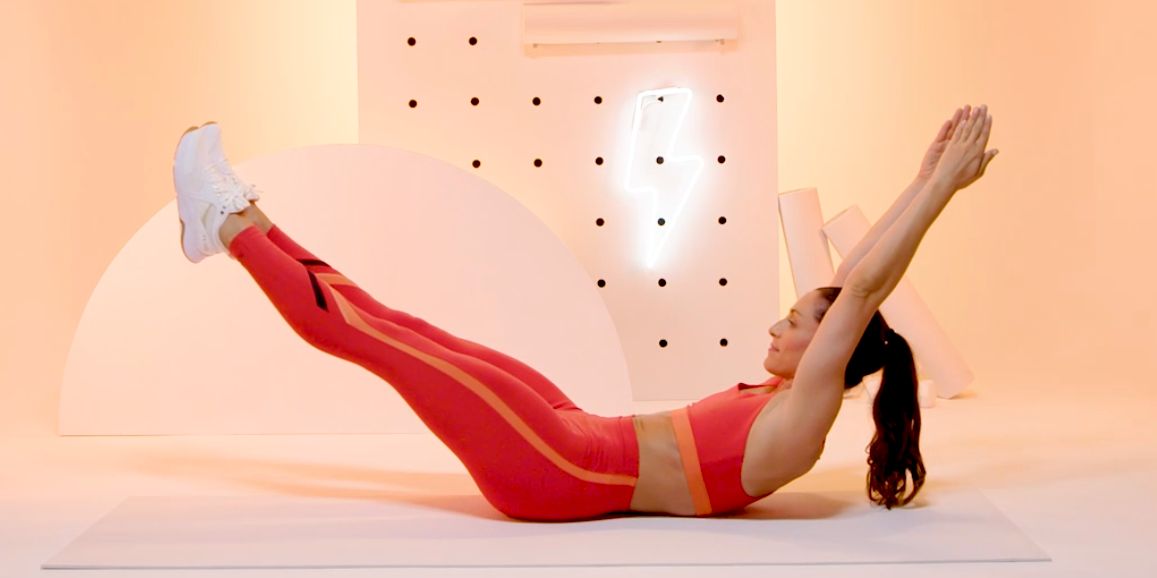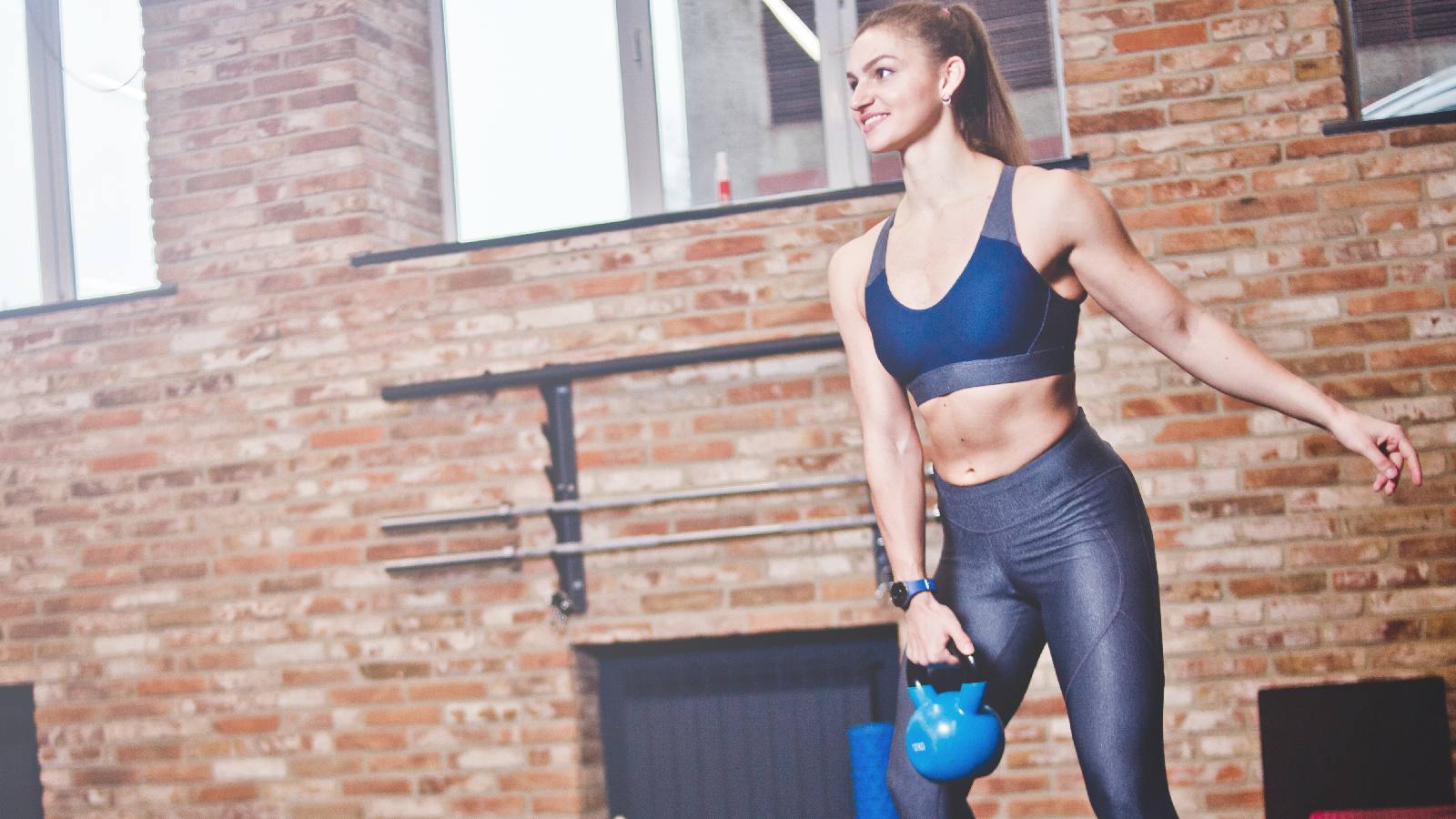Fitness
Look No Further, These Are The 20 Best Abs Exercises Of All Time

I haven’t always loved abs exercises. My old routine of post-run crunches and planks was not it. Lately, I’ve found more motivating moves (hi, practicing Pilates everyday and a kettlebell ab workout) that make me look forward to my abs routine. It is possible.
What I’ve learned along the way and trainers will agree, a strong core is always worth the effort and finding abs exercises you enjoy. It helps you squat heavy weights, improve your balance, hike up the stairs (or a mountain) with ease, run fast or long distances, and more.
Your abdominal muscles play a major role in your ability to hit these goals and are so much more than a “six-pack.” (Seriously.) One surefire way to achieve that super strong core: abs exercises. And some abs moves are far superior. (BTW here’s how to get visible abs if that’s a goal for ya.)
Meet the expert: Tatiana Firpo, CPT, is a certified personal trainer and self defense coach and training manager for Fit Hit.
Before you can work your middle muscles with the best abs exercises of all time, you need to know a bit more about your core. A successful ab workout incorporates movements that use *all* of these major muscles—preferably at the same time, says Tatiana Firpo, CPT (because efficiency!).
- Rectus abdominis – a.k.a., your six-pack muscles, which run down the front of your stomach)
- Transverse abdominis – deep abs muscles that wrap around your stomach
- Obliques – otherwise known as your side abs, which help you rotate
As you approach this workout from Firpo, focus on pulling your navel in toward your spine to keep your abs muscles engaged. If you’re doing a movement on your back, make sure to press your lower back into the floor so your abs do the work—not your spine. The 20 moves below are some of the best abs exercises you can do. No matter how you mix and match them, you’ll get an abs workout that’ll strengthen your core in no time.
20 Best Abs Exercises
Time: 10 to 20 minutes | Equipment: Resistance band, yoga block (both optional) | Good for: Abs, core
Instructions: Choose three exercises from the list below. Perform each for 30 to 60 seconds, then immediately continue to your next move. Once you’ve completed all three, rest for 15 to 30 seconds, then repeat for 3 to 5 total rounds.
1. Glute Bridge March
How to:
- Lie on your back with your legs bent, heels under knees, feet flat on the floor.
- Extend your arms over your chest, palms facing.
- Raise your hips so your body forms a straight line from your shoulders to your knees.
- Brace your abs and lift your right knee over your hip, maintaining 90-degree angle of that leg.
- Hold for a moment, then lower your right foot.
- Repeat with the left. That’s 1 rep.
- Continue alternating.
Good for: rectus abdominis, transverse abs
Why it rocks: Not only does this exercise fire up two sections of your abs, but it works your glutes, too, which will help with your overall stability.
2. Mountain Climbers
How to:
- Start in a plank position.
- Drive right knee toward chest.
- Return to a plank.
- Quickly repeat with left knee. That’s 1 rep.
- Continue alternating.
Good for: rectus abdominis
Why it rocks: Yup, this workout makes your core seriously burn and gets your heart pumping, a combo that’s sure to help you up your fitness game.
3. Plank With Knee Tap
How to:
- Get into a plank position, with elbows stacked under shoulders.
- Slowly and with control, lower both knees until they kiss the ground.
- Return to a plank position. That’s 1 rep.
Good for: rectus abdominis
Why it rocks: This slow movement helps you engage your core while also easing strain on your neck by allowing your knees to periodically touch the ground.
4. Shoulder Tap And Jack
How to:
- Get into a plank position, with hands stacked directly under shoulders.
- Keeping core engaged, tap right shoulder with left hand as you jump feet outward. Return to start.
- Repeat on the opposite side. That’s 1 rep.
Good for: obliques, transverse abs, rectus abdominis
Why it rocks: Not only does this work all aspects of your core, but the move also allows you to get your heart rate up for a boost of cardio.
5. Leg Lower
How to:
- Start lying on back with arms on mat and hands under butt, palms down, legs raised at a 90-degree angle from the floor, feet flexed.
- Slowly lower one leg as far down as possible without back lifting off the ground.
- Return to start.
- Repeat with the other leg. That’s 1 rep.
Good for: transverse abs, rectus abdominis
Why it rocks: You’re able to fully engage your abs by moving slowly downward without the injury-risk associated with faster movements.
6. Deadbug
How to:
- Start lying on back with arms extended toward ceiling in line with shoulders and legs bent to 90 degrees (knees above hips).
- Keep low back pressed into the floor, engage abs, and slowly extend and lower right leg until heel nearly touches floor and left arm until your hand nearly touches floor overhead at the same time.
- Pause, then return to start and repeat on the opposite side. That’s 1 rep.
- Continue alternating.
Good for: rectus abdominis, obliques, transverse abs
Why it rocks: This slow-and-controlled move strengthens and stabilizes (good for posture and easing low-back pain) without the threat of neck strain.
7. V-Up
How to:
- Start lying on back with legs extended and arms by sides, both on mat.
- In one movement, lift upper body, arms, and legs, coming to balance on tailbone, forming a “V” shape with body.
- Lower back down. That’s 1 rep.
Good for: rectus abdominis
Why it rocks: Because it involves lifting your arms and legs, this difficult move gets your heart rate up while pushing your core strength to its limit.
8. Side Plank
How to:
- Start lying on side with right forearm flat on the floor, elbow under shoulder, and both legs extended. Body should form a straight line from head to feet, which are either stacked or staggered.
- Engage core and lift hips up.
- Hold for 30 seconds before repeating on the other side.
Good for: obliques, transverse abs, rectus abdominis
Why it rocks: By working your core, hips, and shoulders one side at a time, side planks help you avoid strength imbalances.
9. Reverse Crunch
How to:
- Start lying on back, legs lifted so thighs are perpendicular to ground and extended. (Option to bend knees as a modification.)
- Press lower back into mat, then curl knees into chest to lift hips off the ground.
- Return to start with control. That’s 1 rep.
Good for: rectus abdominis
Why it rocks: The reverse crunch fires up your rectus abdominis, transverse abdominis, and obliques without straining your neck and back.
10. Hollow Body Hold
How to:
- Sit on a mat with legs bent. (For an extra challenge, place a yoga block between knees.)
- Squeeze legs together and engage abs to lift bent legs so calves are parallel to the floor.
- Lift head, neck, and shoulders the floor.
- Pause and hold for 30 seconds or as long as possible with good form.
Good for: rectus abdominis, transverse abs, obliques
Why it rocks: This advanced move is a true test of core strength. You can up the challenge even more by adding ankle weights.
11. Lateral Bear Walk
How to:
- Start in bear plank, with shoulders over wrists and knees under hips, hovering a few inches off of the floor.
- Keeping hips stable, head in line with tailbone, and knees lifted off of the floor, move hands and feet left for three steps. (Don’t let feet or hands cross.)
- Then, move hands and feet right for three steps. That’s 1 rep.
- Repeat on other side and continue alternating.
Good for: obliques, rectus abdominis, transverse abs
Why it rocks: In addition to hitting your entire core, this more unusual movement pattern is great for coordination.
12. Bear Crawl
How to:
- Start in bear plank, with shoulders over wrists and knees under hips, hovering a few inches off of the floor.
- Keeping hips stable, head in line with tailbone, and knees lifted off of the floor, slowly step opposite hand and foot forward, repeating with other hand and foot for four steps total.
- Then, reverse the movement to step backward and return to start. That’s 1 rep.
Good for: rectus abdominis, transverse abs
Why it rocks: The bear crawl fires up all of your major muscle groups to improve your muscular endurance. Speed it up and you’ll get some cardio perks, too.
13. Heel Taps
How to:
- Start on back with knees bent and feet on floor, hands by hips.
- Lift chest toward the ceiling, keeping neck relaxed and bringing shoulder blades off the ground.
- Tap right hand to outside of right ankle, flexing right obliques in the process.
- Come back to center, keeping shoulders off ground.
- Tap left hand to outside of left ankle. That’s 1 rep.
Good for: obliques
Why it rocks: Easy-to-understand heel taps target your obliques in a big way. You’ll feel the burn instantly.
14. Bear Plank With Leg Extension
How to:
- Start in bear plank, with shoulders over wrists and knees under hips, hovering a few inches off of the floor.
- Keeping hips stable, head in line with tailbone, and knees lifted off of the floor, squeeze core to remain still.
- For an extra challenge, lift one foot up off the floor for a few seconds, extending leg back straight behind you.
- Replace the foot on the floor, then repeat with the other leg.
Good for: rectus abdominis, obliques, transverse abs
Why it rocks: This deceivingly difficult move gives you the perfect opportunity to really squeeze and engage those abs muscles.
15. Seated Rotation
How to:
- Sit on the floor and lean upper body back until abs are engaged.
- Legs should be bent at 90 degrees with heels on mat, and arms should be bent, hands clasped, with elbows wide. This is your starting position. (Option to hover feet off the mat for extra challenge.)
- Rotate torso to right side so that right elbow is hovering just off mat.
- Keep lower body still while rotating upper body to left side until left elbow is just off mat.
- Return to start. Gaze follows hands as you move. That’s 1 rep.
Good for: obliques
Why it rocks: This classic obliques move is easy to modify. Make it easier by keeping feet planted, or up the intensity by hovering feet or holding a weight with hands.
16. Banded Bird Dog
How to:
- Start on all fours, with hands stacked directly under shoulders, knees below hips, and a resistance band wrapped around feet.
- Keeping torso still and core engaged, simultaneously extend right arm straight out in front of body and left leg straight back behind body.
- Bring right elbow and left knee in beneath torso to touch.
- Repeat on the opposite side. That’s 1 rep.
Good for: rectus abdominis, transverse abs
Why it rocks: This banded move comes with the added bonus of working your core and glutes.
17. Cross-Body Iso Deadbug
How to:
- Start by lying on back with hands at sides and legs straight, feet flexed.
- Bring left knee and right hand together at hip level and actively push them into each other until abs are fully engaged.
- Hold for 10 seconds, then switch sides. That’s 1 rep.
Good for: obliques, rectus abdominis
Why it rocks: This move is beginner-friendly, easy on your head and neck, and quick to make your six-pack muscles shake.
18. High Plank Rock
How to:
- Start in a high plank position with wrists under shoulders and body in a straight line from head to heels.
- Engage abs and shift forward, rocking on toes, while maintaining body alignment.
- Shift back to start. That’s 1 rep.
Good for: obliques, rectus abdominis, transverse abs
Why it rocks: The instability of the ball in this advanced move makes for a unique (and intense!) challenge for your core muscles.
19. Scissor Kicks
How to:
- Lie on back with arms down by sides, palms down and pressed into mat.
- Engage core by pressing lower back into mat and tucking pelvis as you lift both legs about six inches off the ground (roughly a 45-degree angle) with feet flexed or pointed.
- Raise right leg to 60 degrees, while holding left leg in space.
- Then, lower right leg to 45-degrees as you raise left. That’s 1 rep.
- Continue alternating legs, up and down, keeping knees as straight as possible.
Good for: transverse abdominis, rectus abdominis, obliques, and hip flexors
Why it rocks: This advanced move is one of the most effective core burners you can do because it engages all the abs muscles simultaneously, You can do it all without neck strain, too.
20. Plank
How to:
- Start sitting on heels.
- Walk hands out until wrists are under shoulders when legs are extended fully and body forms a straight line from shoulders to heels.
- Balance on balls of feet, keep abs engaged, and gaze slightly forward. Hold this position.
Good for: transverse abs
Why it rocks: Probably the most important abs exercise in the game, the plank targets more muscles than most moves. Adding it to your routine is non-negotiable.

Jennifer Nied is the fitness editor at Women’s Health and has more than 10 years of experience in health and wellness journalism. She’s always out exploring—sweat-testing workouts and gear, hiking, snowboarding, running, and more—with her husband, daughter, and dog.

Fitness
Lift in gym to lift your mood: Study shows getting ripped reduces depression risk

Dec 20, 2024 06:22 PM IST
Building muscle may as well be building a mental fortitude as a study reveals that muscle mass strength lowers depression risk.
Fitness
Jane Fonda, 86, is back as fitness guru in new virtual workouts from Meta

© 2024 Fortune Media IP Limited. All Rights Reserved. Use of this site constitutes acceptance of our Terms of Use and Privacy Policy | CA Notice at Collection and Privacy Notice | Do Not Sell/Share My Personal Information
FORTUNE is a trademark of Fortune Media IP Limited, registered in the U.S. and other countries. FORTUNE may receive compensation for some links to products and services on this website. Offers may be subject to change without notice.
Fitness
Want to Run a Fast 5K? Here’s Everything You Need to Do

Just about anyone can run a 5K. At 3.1 miles, it’s long enough to challenge both the beginner and advanced runners, and everyone in between. Perhaps this is why so many of us, especially those who are just getting started with running, are interested in tackling the distance. But with so much variability, it’s not easy to figure out what makes a good 5K time, and how to set your own goals.
That’s why we dug up data on the average 5K finish time. Plus, we reached out to a couple of coaches to help you set your own 5K goals and understand what it takes to get better at running the distance. Here’s what you need to run your best.
What’s a good 5K time?
The average 5K finish time is 39:02, based on data collected from 2000 to 2018 and reported by Run Repeat. Meanwhile, the average 5K finish time for Strava users across the globe who uploaded their runs from September 2023 to August 2024 was 28:30 and in the U.S., runners clocked an average of 28:28 for 3.1 miles.
These could all be considered good 5K times. However, finish times are relative to a variety of factors, including fitness level, experience, current training, age, and more.
For example, “someone’s age can influence someone’s finishing time because as we age, physical capabilities tend to decline, which can lead to slower running speeds and longer finish times,” says Melissa Kendter, an ACE-certified functional strength trainer and running coach.
Finish times can also vary depending on gender. For example, the average finish time for men, according to Running USA based on race data collected from 2013 to 2023, is 32 minutes and for women, it’s 39 minutes.
Simply put: Someone else’s fast may be considered someone else’s slow, and vice versa. This is why you should set your own goals that are personal to you, and also look beyond finish time and focus on giving your best effort.
How can I set a good goal time for my first 5K?
When it comes to goal setting for a 5K, remember that you don’t always have to set a goal to finish in a certain time—especially if this is your first go at the distance.
“Your goal could just be to complete a 5K. It could be focusing on finishing the race regardless of the time. Just an accomplishment of doing it, I mean that in itself is huge. Not everybody’s going out every day running 3.1 miles,” says Kendter.
You can also focus your training and racing on improving your mental health or overall fitness, she adds.
If you do want to hit a specific time goal, you can predict your 5K finish time with a time trial before you start training and then set your goal time based on how you did.
To estimate your 5K pace with a one-mile time trial, Kendter recommends starting with a 10 minute jog to warm up then running one mile at your best effort.
After you finish, plug your total time into a race pace calculator, like ours, to estimate 5K finish time. You can also use our training pace calculator, using that mile time, to figure out your paces for workouts like long runs, tempos, and intervals leading up to race day. This can especially come in handy if you don’t have access to a coach, says Kendter.
What can you do to make sure you run your best?
Build Your Aerobic System
To complete the 5K comfortably, you have to consider it as both an endurance and a speed event, says Kendter. “You have to train your aerobic system to carry you through the 20 to 30 minutes, or however long it takes you. But you also have to train for speed appropriately, so that your aerobic system can then support the speed that you want,” she explains.
To do that, you want to include different types of runs throughout the week.
What types of runs should you do? Kendter recommends following a training plan that has a mixture of speed, long, and easy runs on the schedule each week, and lasts about four to eight weeks. This will not only help you build the endurance and speed you need, but it will also keep you consistent, which is important too.
“Just like anything else in life, it’s deliberate practice,” says Benson Lang’at, RRCA coaching certification instructor and level 2 certified coach, who stresses the importance of nutrition, stretching, and strength training in addition to running. “Really to get faster, you’ve got to do the things that help you meet the demands of what you’re trying to accomplish,” he adds.
This means running longer to build a solid base before implementing speed workouts like interval and tempo runs to get faster, and even developing and executing a good racing strategy to help you reach the finish line.
Add Speed Workouts to Your Calendar
As we mentioned, speed workouts play a critical role in training for a 5K because they will help get fitter and faster.
“You only want to do one to two speed workouts a week, and you want to pace them appropriately throughout the week, so that your body can recover in between and then gain the adaptations from the hard work,” says Kendter. This is why your speed workouts should be completed before a rest day, easy run, or active recovery day.
To help you get faster, Kendter recommends completing 10 rounds of one minute hard, one minute easy intervals to start. Then each week you can progress your workouts by increasing the intervals by one minute. This workout will help to train your VO2 max system, she says.
You can also add distance-specific speed work like 400-meter repeats to your calendar. Kendter recommends completing six rounds of 400 meters with a recovery jog of 400 meters in between each round. This workout should equal out to about four to five miles.
Monitor Your Progress
As you gear up for your first or next 5K, you can check your splits during or after your workout to make sure you’re hitting your goal paces. If you have a running watch like a Garmin or Coros, you can easily monitor your split times on your wrist, or you can record them and predict your finish time with a pace chart or calculator postrun.
If you notice you’re consistently hitting your target paces for each interval after adequate recovery, then this can be a strong indication you’re on track to hit your goal time for a 5K, says Lang’at. For example, if your goal is to break 20 minutes, then you’d want to complete 400-meter repeats at approximately a 5:39 min/mi pace, he explains.
Check the Elevation Map
Geography is another factor that can influence your race day performance, especially if you can expect to run hills on race day.
Even the slightest elevation change can slow you down, says Lang’at. This is why he recommends running hills when your training if you can expect to run them on race day.
It’s also why many runners opt for a flat or downhill course if the goal is to run a personal best.
Train for the Elements You Can Expect on Race Day
When it comes to running your best it’s important to understand how your body will respond to the weather, especially if you’re aiming for a personal best. For example, in colder conditions you want to make sure you’re dressed properly, particularly not wearing too many extra layers, and in hotter conditions you want to make sure you’re well hydrated (you always do, but especially when you’re overheated and sweating more).
Luckily, setting yourself up for success doesn’t have to be overly complicated. For starters, you can acclimate yourself to the certain weather conditions by training in them, says Lang’at. Also, check for season-specific gear guides to make sure you’re dressed appropriately (and can test our your outfit before race day).
Work With a Coach
If you really have your eyes set on running your best, working with a coach is a good approach to take.
If you want to hit a certain goal time, then working with someone who can guide you, will help you better manage your expectations, says Lang’at. For example, if you want to break 25 minutes, a coach can assess your fitness levels and adjust your training so you can reach this goal. Also, throughout your training a coach can monitor your progress and adjust your training accordingly, and also keep you motivated.
Monique LeBrun joined the editorial staff in October 2021 as the associate health and fitness editor. She has a master’s degree in journalism and has previously worked for ABC news and Scholastic. She is an avid runner who loves spending time outside.
-

 Politics1 week ago
Politics1 week agoCanadian premier threatens to cut off energy imports to US if Trump imposes tariff on country
-
/cdn.vox-cdn.com/uploads/chorus_asset/file/25782636/247422_ChatGPT_anniversary_CVirginia.jpg)
/cdn.vox-cdn.com/uploads/chorus_asset/file/25782636/247422_ChatGPT_anniversary_CVirginia.jpg) Technology1 week ago
Technology1 week agoInside the launch — and future — of ChatGPT
-
/cdn.vox-cdn.com/uploads/chorus_asset/file/25789444/1258459915.jpg)
/cdn.vox-cdn.com/uploads/chorus_asset/file/25789444/1258459915.jpg) Technology6 days ago
Technology6 days agoOpenAI cofounder Ilya Sutskever says the way AI is built is about to change
-

 Politics6 days ago
Politics6 days agoU.S. Supreme Court will decide if oil industry may sue to block California's zero-emissions goal
-
/cdn.vox-cdn.com/uploads/chorus_asset/file/25546252/STK169_Mark_Zuckerburg_CVIRGINIA_D.jpg)
/cdn.vox-cdn.com/uploads/chorus_asset/file/25546252/STK169_Mark_Zuckerburg_CVIRGINIA_D.jpg) Technology7 days ago
Technology7 days agoMeta asks the US government to block OpenAI’s switch to a for-profit
-

 Politics1 week ago
Politics1 week agoConservative group debuts major ad buy in key senators' states as 'soft appeal' for Hegseth, Gabbard, Patel
-

 Business5 days ago
Business5 days agoFreddie Freeman's World Series walk-off grand slam baseball sells at auction for $1.56 million
-
/cdn.vox-cdn.com/uploads/chorus_asset/file/23951353/STK043_VRG_Illo_N_Barclay_3_Meta.jpg)
/cdn.vox-cdn.com/uploads/chorus_asset/file/23951353/STK043_VRG_Illo_N_Barclay_3_Meta.jpg) Technology5 days ago
Technology5 days agoMeta’s Instagram boss: who posted something matters more in the AI age


























/cdn.vox-cdn.com/uploads/chorus_asset/file/25799696/Raveen_Rao_CL_site_wide.png)










